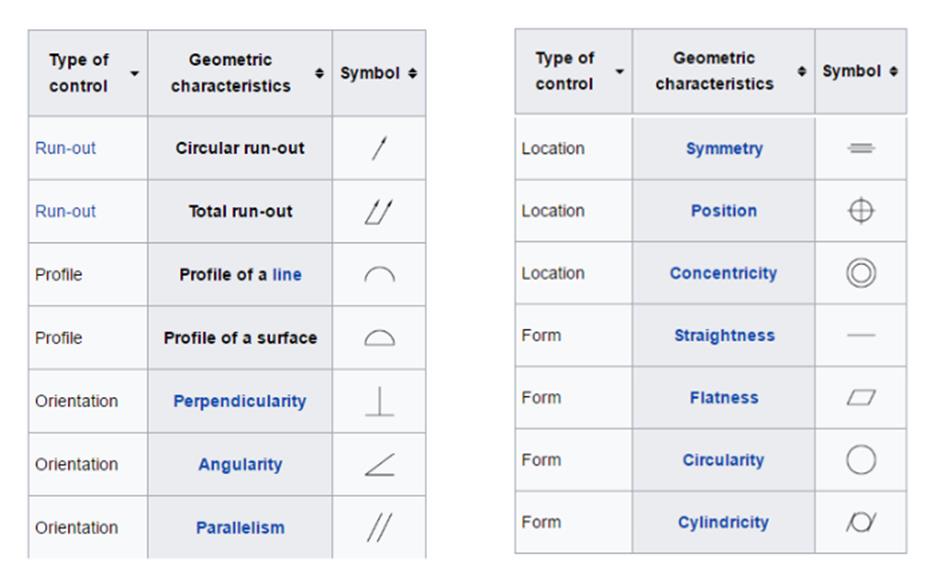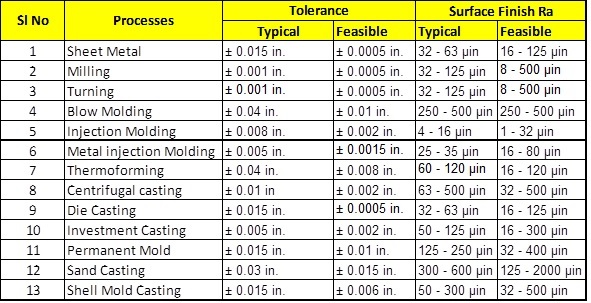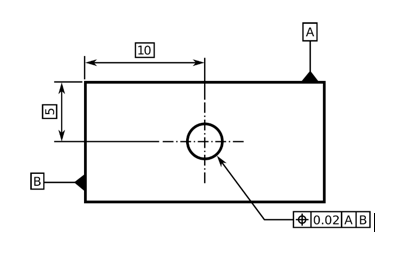Does Dimensional Tolerances Impact Part Production Costs?
Dear Readers, I am happy to publish my 3 rd blog in Imoran Cost Engineering under the guidance of our founder & CEO Mr Sebastian Moeller.
I am grateful to him for giving me an opportunity to come up with different articles under costing category, which would be useful for budding and fellow cost engineers.
This blog explains in detail about the impact of dimensional tolerance in production costs.
I request my friends, ex colleagues and connections in LinkedIn to kindly read this blog and share your feedback, comments and suggestions.
Preface:
- What is Dimensional Tolerance?
- Types of Geometric Tolerance?
- Tolerance & surface finish for different processes.
- How dimensional tolerance impact part production cost.
- Increasing design tolerance can cut costs.
- How increasing design tolerance can actually cut costs.
- Conclusion
What is Dimensional Tolerance?
Dimensional tolerance is related to, but different from fit in mechanical engineering, which is a designed-in clearance or interference between two parts. Tolerances are assigned to parts for manufacturing purposes, as boundaries for acceptable build. Tolerances can be applied to any dimension.
Types of Geometric Tolerance

Tolerance & Surface Finish for different processes

How dimensional tolerance impact part production cost
Custom-manufactured components are defined by engineering drawings for consistent production.
Drawings define the allowable tolerance of each dimension.
Dimensional tolerances should be determined based on how the parts fit together and what the parts are intended to do.

How much will a custom-manufactured component ultimately cost to produce?
The answer depends on several factors.
These unique parts are defined by engineering drawings, which are used by the design engineer to communicate all of a part’s characteristics to the manufacturer so that it can be consistently produced.
The drawing contains numerical dimensions that define the size and location of every feature of the part. It also communicates other important attributes, including the material, surface finishes, fabrication methods and other industrial processes necessary to create the part. All of these variables contribute to the bottom line of total overall production cost.

Probably, one of the most important requirements a drawing also defines is the tolerance of each dimension. The tolerance defines the acceptable amount of deviation from the dimension’s nominal value. The “allowable tolerance” window can have a dramatic effect on the manufacturing method and total cost of producing the part. As a general rule, the smaller the allowable deviation, the larger the amount of money it takes to manufacture. This phenomenon is due to the fact that extremely precise dimensions are more difficult to achieve and increase the chance of rejection, rework and scrap.
Also, a “tight tolerance” could require the manufacturer to use much more expensive production methods, machine tools, inspection devices and a significantly greater amount of total processing time. This can add up to a significant amount of money if applied to hundreds of dimensions on the hundreds of custom parts that make up an entire machine. If the machine will be duplicated hundreds of times, the cost increases are exponential.

It is the designer’s responsibility to determine every dimension’s tolerance and make sure that it is contained in the drawing. Dimensional tolerances should be determined based on how the parts fit together and what the parts are intended to do. A designer should ask the question: Will the parts go together and function if I allow a greater amount of variation? If the answer is a definitive “yes,” then a larger tolerance should be allowed. From a cost perspective, dimensional tolerances should be as large as possible without impacting the assembly or the performance of the part.
Optimum manufacturers can assist customers with dimensional tolerances, the overall manufacturability, and also cost optimization of their designs. These activities can dramatically reduce not only the cost of manufacturing, but also the amount of time it takes to produce the equipment.
Increasing Design Tolerance Can Cut Costs
The product design and development process is a fascinating one, combining creativity with the disciplines of math, science, engineering and marketing. Transforming an idea into a marketable product doesn’t just happen.
Involving a best manufacturer who can help determine whether your design is actually ready to be made is a great first step.
This usually means that the manufacturer you’re working with has its own design services division or works closely with a design services firm. Either way, this is a critical element in the process. You want someone going over your design with a fine-toothed comb looking for ways to make your product more efficiently or less expensively.
One design flaw, we see frequently on customer’s designs is over tolerancing. Tolerance is the specific amount or variable, the plus or minus, allowed in a dimension. Typically, these are drawn very tightly, much more tightly than they need to be. Your manufacturer and the design service folks they partner with are putting effort into making sure your product design:
· Is manufacturable
· Is easy to assemble
· Gets sufficient yields in production
· Avoids processes that might induce defects
Tight tolerances can be a tug of war between designer and manufacturer, and these are that last bit of perfection designers add. Tight tolerances mean the product is less likely to fail in the field, but at what cost?
Why Such Tight Tolerances?
We’ve learned that tight tolerances are sometimes just numbers on paper without much thought behind them. Sure, a customer might think a tight tolerance was necessary, or even critical for fit or function but on further review they discover it’s not critical at all. Here’s the big takeaway: Tolerances should always be motivated by the material selection, manufacturing process used and how sensitive your features are to variations. An experienced contract manufacturer will identify the tolerances that are unnecessarily tight and suggest more appropriate ranges, which could ultimately significantly reduce costs.
Design Tolerance Standards
When customers turn in their drawing, they usually specify design tolerances. If not, we’ll recommend the class and standard to follow. We reference two standards for mechanical tolerances, ASME Y14.

Now, let’s look at tolerance and how loosening up tolerances can help not just the design but the bottom line.

Four Ways Tight Tolerances are Costing You Money :
- Tools are more expense – Higher grade materials offer more precision but are much more expensive to make. The tighter the tolerance the more it costs.
- Added processes – Tighter tolerances typically need extra processes, which require more machinery, tools and operations. An example would be adding a surface finish to metal. Secondary operations would include grinding, honing and polishing, all labor and cost intensive.
- Required inspection / testing – Critical tolerances call for closer inspections. Whether the testing is manual or automated, it’s another layer of testing (and another layer of expense). Sometimes such testing requires inspection of each individual component, with very strict guidelines about rejecting parts that are out of spec – even for those pieces that could be used if the tolerances were more reasonable. The higher rejection rates cause the testing price to skyrocket.
- Precision machinery and equipment – If you choose to keep your tight tolerances and work with a contract manufacturer, one of three things will happen that will cost you more money:
Your manufacturer will use niche, precision machinery and charge you a premium.
The supplier will buy the expensive precision machinery and pass on that cost to you.
Your work will be outsourced to a supplier with those capabilities.
The thing is, you don’t lose anything by having a designer look at the design to see where the tolerances can be loosened. Some places might be critical, but others might not. A good engineer will look at your design and ask questions.
Questions to ask:
What is the part’s function?
Can this tight tolerance be justified or is it non-critical?
Is this tight tolerance critical for fit or function?
What process is being used? (For example, were machining tolerances applied when casting tolerances would have been more appropriate?)
What material is the part made of?
What this tolerance passed down in a legacy product design? Is the measurement still appropriate or accurate or could it do with a re-design?
Tolerance is one of those areas that is in the buyer’s hands. It’s your responsibility as the buyer to tell your contract manufacturer what you will and will not accept in terms of tolerances.
And your contract manufacturer and design services team can help. They can identify those unnecessarily tight tolerances and suggest more appropriate ranges. The manufacturer will own this project from the time its on paper until the product sunsets and they want it to be successful. So here’s one place you might want to consider starting – can you loosen up the tolerances?
How increasing design tolerance can actually cut costs
- Determine the functionality of a product
The functionality of a product determines how it will be designed and produced. In some cases, tolerances of even a single decimal can mean the difference between a functioning product and a failed one. That is only the case if product functionality depends on tight tolerances. However, materials used in the manufacturing process also play a role in determining acceptable tolerances in product design. In other words, not every part of the product needs tight tolerances, but in most cases, the entire product is based on strict requirements.
For instance, a product with a certain number of components requires a tolerance of ± 0.001 because there’s a specific way component must fit together. But, a separate part is also automatically specified using the same tolerances, even if the part does not interact with the others or may not need the same tolerances. That’s why it’s important to determine the functionality of the product and which component – if any – requires a tight tolerance to function.
- Consult with a manufacturer
Creating a product design eventually comes down to tolerances that are numbers on paper. You may think that those tolerances are absolutely necessary, even if that’s not the case. Tolerances are influenced by the materials used in production, how they’re made during manufacturing and the sensitivity of product features to variations in design. That’s why it’s important to have an experienced manufacturer on board that can help you determine if there’s room to increase the design tolerance or not.
For example, if you’re developing a design for precision components, you should consult with a manufacturer. That way, a manufacturer can go over your design and help you determine the acceptable increases intolerances to help you cut costs. Your manufacturer will know how to best implement those tolerances, without compromising the product’s functionality and quality.
 3. Understand the costs of tight tolerances.
3. Understand the costs of tight tolerances.
As mentioned before, product developers and designers focus on tight tolerances in order to ensure product quality. The reality is that tight tolerances do not always influence quality, but they are always expensive to implement. You need to consider these costs before insisting on tight tolerances. For example, tight tolerances require more precise tools and higher grade materials, which cost a lot more. The tighter the tolerance is, the more it will cost you. In addition, tight tolerances require more processing, which increases the costs of the machinery used and labor.
Moreover, you need to pay for a close inspection to determine whether the tolerances are within the acceptable range. What’s more, if you cannot implement tight tolerances on your own, you may need to outsource the process, which will cost you more. In the end, you end up paying for precision that may not be required. That’s why it’s important to actually determine if tight tolerances are mandatory for your products. If you don’t need such tolerances, you should take the opportunity to implement more appropriate variables and greatly reduce the costs of product development.
4. Don’t relax tolerances too much
In an effort to cut costs, increasing the design tolerance is quite beneficial. However, relaxing the tolerances too much involves certain risks. For example, the product components may not fit well together if tolerances are too extreme. In addition, your customers may disapprove of increased tolerances, if you haven’t consulted with them beforehand. Also, you may need to repeat the manufacturing process and redesign your products if you’re not careful with tolerances.
That will only skyrocket your costs. Instead of focusing on tight tolerances or relaxing them too much, you should focus on implementing quality assurance and tolerance analysis. That way, you’ll be able to determine exactly which variables are acceptable for your product design. In addition, you’ll know exactly where to apply strict tolerances and, of course, how much you can increase them to cut costs.
Conclusion
Product design is important for the manufacturing and quality of the products. However, ensuring product quality doesn’t always rely on implementing strictly tight tolerances. Tight tolerances are only required when there are specific needs and functionality requirements. Other than that, you can consider relaxing the product design tolerance and save yourself a lot of money during the development process.



